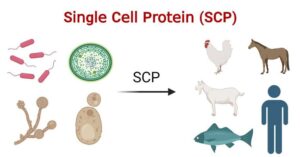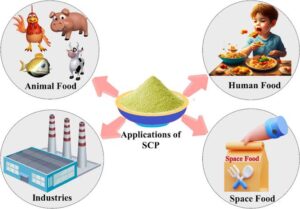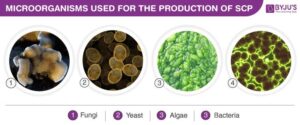Back to: MICROBIOLOGY 400 LEVEL
Welcome to class!
Welcome back, brilliant mind! It’s such a joy to have you here again. You’ve been learning consistently, and that commitment will take you far. Today, we’re focusing on a very practical and future-forward topic: Microbial Biomass and Single-Cell Protein (SCP). This area of microbiology is helping the world solve hunger, improve health, and create new foods. Let’s make it clear and easy to understand, with examples you can relate to right here in Nigeria.
Microbial Biomass And Single-cell Protein
Microbial biomass simply means the total mass of microorganisms in a given environment or culture. This could be in soil, water, a fermenter, or any medium where microbes grow. It includes bacteria, fungi, algae, and even yeast.

But beyond just being a number, microbial biomass can be harvested and used as a resource. Microorganisms are rich in protein, vitamins, and other nutrients, and when grown in large quantities, their biomass can serve as a nutritional product for animals and even humans.
What is Single-Cell Protein (SCP)?
Single-Cell Protein refers to protein extracted from cultured microbial biomass, especially from unicellular organisms like yeast, algae, fungi, and bacteria. These proteins can be used as animal feed or human food, especially in places where conventional protein sources like meat and fish are expensive or scarce.
SCP can be produced from a variety of low-cost materials like molasses, agricultural waste, sawdust, or even wastewater, making it a cost-effective and sustainable solution for food production.
Microorganisms Used for SCP
Here are some key microorganisms commonly used in producing SCP:
Yeasts: Saccharomyces cerevisiae (also used in bread and beer) is rich in protein and B vitamins.
Fungi: Fusarium venenatum is used to make mycoprotein (e.g., Quorn meat substitute).

Bacteria: Methylophilus methylotrophus and Bacillus subtilis are fast-growing and useful in SCP production.
Algae: Spirulina and Chlorella are high in protein and already used in food supplements in Nigeria and other countries.
Benefits of SCP
High protein content – Some microbial protein contains up to 60–80% protein.
Quick production – Microbes grow fast and can be harvested daily.
Can be grown on waste – Helps reduce environmental pollution.
Reduces food insecurity – Provides an alternative protein source in low-resource settings.

In many parts of Nigeria, Spirulina is added to health supplements because of its rich nutritional value. Some farmers use yeast-based feeds to nourish their poultry and fish. Also, imagine using cassava peels or maize husks to grow microbes that become food—that’s SCP in action, turning waste into wealth.
Summary
- Microbial biomass is the total mass of microorganisms in a culture or environment.
- Single-Cell Protein (SCP) is protein obtained from microbial biomass used as food or feed.
- SCP can be produced from yeast, fungi, algae, or bacteria grown on inexpensive substrates.
- SCP is rich in protein and vitamins, grows quickly, and can be produced using agricultural waste.
- SCP helps address food insecurity and supports sustainable agriculture and health.
Evaluation
- Define microbial biomass and Single-Cell Protein (SCP).
- Name two microorganisms commonly used for SCP production.
- List two advantages of SCP over traditional protein sources.
This knowledge isn’t just for passing exams—it can shape the future of food and health in Africa. You are learning the tools to become a change-maker in science and society. Keep believing in yourself, and remember, with Afrilearn, your success is just getting started. See you in the next class!
